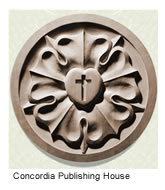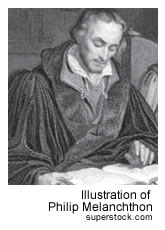by Rev. Herbert C. Mueller Jr.
In Article II of our Synod’s constitution, we state that the members of our Synod accept “without reservation (1) The Scriptures of the Old and the New Testament as the written Word of God and the only rule and norm of faith and of practice; (2) all the Symbolical Books of the Evangelical Lutheran Church as a true and unadulterated statement and exposition of the Word of God.”
Article II then lists the documents found in the Book of Concord of 1580. But why are we tied to these 500-year-old (and, in some cases, even older!) writings?
More than historic relics, our confessions identify who we are as Lutherans, connect us to the Church of all ages, and most of all, keep the Gospel of Christ crucifi ed for sinners at the heart of our life and proclamation.
Our Common Faith
 The first three of our confessions are not peculiar to Lutherans; they are shared by the whole Church. Written to combat false teaching, the Apostles, Nicene, and Athanasian creeds summarize teachings of Scripture held in common by all believers. We speak them in church as the living voice of the faithful who have gone before us. Next time you say the Creed, note the clear confession that the Jesus who died and rose for us is fully God and fully human.
The first three of our confessions are not peculiar to Lutherans; they are shared by the whole Church. Written to combat false teaching, the Apostles, Nicene, and Athanasian creeds summarize teachings of Scripture held in common by all believers. We speak them in church as the living voice of the faithful who have gone before us. Next time you say the Creed, note the clear confession that the Jesus who died and rose for us is fully God and fully human.
Our confessions also locate us within the “one holy catholic (i.e. universal, Christian) and apostolic church” (Nicene Creed). They show our teaching to be not a human invention (e.g., by Martin Luther), but the true teaching of the Church from the beginning. Scripture itself is the fi nal authority, but our confessions teach us how to read the Bible so that Christ and the Gospel remain the beating heart of the Church’s life. We use the confessions as a standard that has been found faithful to the standard.
A Winsome Summary
The Augsburg Confession, considered primary among the specifically Lutheran confessions, was prepared in 1530 by Philip Melanchthon, an associate of Martin Luther, as a winsome summary of Bible teaching. Publicly read in Augsburg, Germany, on June 25th of that year before Charles V, the Holy Roman emperor and the most powerful ruler of the time, this confession shows how every article of faith is intended by God to bring the greatest possible comfort to the penitent sinner. At the heart of the Augsburg Confession and essential for Lutherans is the teaching that “we cannot obtain forgiveness of sin andrighteousness before God through our own merit, work, or satisfactions, but . . . we receive forgiveness of sin and become righteous before God out of grace for Christ’s sake through faith when we believe that Christ has suffered for us and that for His sake our sin is forgiven and righteousness and eternal life are given to us” (Kolb/Wengert, pp. 38, 40; Fortress Press, 2000).
 Philip Melanchthon also wrote the Apology of the Augsburg Confession over the next year to defend the confession against the Roman authorities who tried to refute Lutheran teaching. The Apology thoroughly defends Scripture’s teaching, especially justifi cation by faith alone.
Philip Melanchthon also wrote the Apology of the Augsburg Confession over the next year to defend the confession against the Roman authorities who tried to refute Lutheran teaching. The Apology thoroughly defends Scripture’s teaching, especially justifi cation by faith alone.
Teaching the Basics
Alongside the Augsburg Confession are the Small and Large Catechisms of Martin Luther, both published as tools for pastors and parents to teach the basics of the faith—The Ten Commandments, the Creed, the Lord’s Prayer, etc. See how clearly the Catechism confesses Christ:
I believe that Jesus Christ, true God, begotten of the Father from eternity, and also true man, born of the Virgin Mary, is my Lord, who has redeemed me, a lost and condemned person, purchased and won me from all sins, from death, and from the power of the devil; not with gold or silver, but with His holy, precious blood and with His innocent suffering and death, that I may be His own and live under Him in His Kingdom and serve Him in everlasting righteousness, innocence, and blessedness, just as He is risen from the dead, lives and reigns to all eternity. This is most certainly true. (Luther’s Small Catechism, Second Article, [CPH 1986].)
Making Things Clear
In 1536, word came that the pope might call a council of the church. Martin Luther’s prince instructed him to make clear what could not be compromised. The council did not take place until 1545, but in 1537 Luther published the Smalcald Articles to lay out what such a council should discuss. Philip Melanchthon prepared a companion piece called the Treatise on the Authority and Primacy of the Pope, setting forth our teaching on the Church and the pastoral ministry.
Resolving Issues
After Luther’s death in 1546, Lutheran territories in Europe endured doctrinal controversy over basic teachings such as “the freedom of the will,” “the righteousness of God,” the “person of Christ” and the Lord’s Supper. In addition, war with the Holy Roman Empire made 1546–77 anything but peaceful for Lutherans. In the late 1570s, however, God used the efforts of Jacob Andreae, Martin Chemnitz, and others to resolve the controversies under the Word of God in what is called The Formula of Concord. Carefully, on each issue, they laid out the nub of the controversy, listed what Lutherans on the basis of Scripture affirm, and also clarifi ed what we therefore reject. Every article points to Christ, true God and true man, crucifi ed and raised from the dead for our salvation. For instance, “we teach, believe, and confess the following: (1) That the divine and human natures in Christ are personally united, and therefore, that there are not two Christs (one the Son of God and the other the Son of Man), but one single Son of God and Son of Man” (Kolb/ Wengert, pp. 509–510).
Our Identity
Gathered into the Book of Concord in 1580, all these confessions still identify our congregations and pastors as Lutheran. At every installation of a pastor, he promises to be faithful to them, saying, “I make these confessions my own because they are in accord with the Word of God” (LSB Agenda, p. 179). In so doing, he is telling the people that they should expect from him a ministry focused on Christ crucifi ed for our sins and centered in the Word and Sacraments as God’s way to deliver the benefi ts of Christ’s death and resurrection. This promise, freely made, means the Lutheran pastor will teach and practice this theology because it is the saving truth. Every aspect of Lutheran theology is biblically designed to bring the greatest comfort in Christ to anyone who knows he or she is a sinner in need of grace and forgiveness.
And we desire that gift for everyone.





